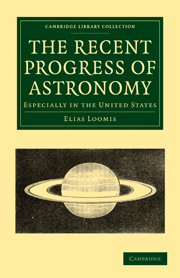Book contents
- Frontmatter
- PREFACE
- Contents
- CHAPTER I RECENT ADDITIONS TO OUR KNOWLEDGE OF THE PLANETARY SYSTEM
- CHAPTER II RECENT ADDITIONS TO OUR KNOWLEDGE OF COMETS
- CHAPTER III ADDITIONS TO OUR KNOWLEDGE OF FIXED STARS AND NEBULÆ
- SECTION I
- SECTION II
- SECTION III
- SECTION IV
- SECTION V
- CHAPTER IV PROGRESS OF ASTRONOMY IN THE UNITED STATES
- POSTSCRIPT
- Frontmatter
- PREFACE
- Contents
- CHAPTER I RECENT ADDITIONS TO OUR KNOWLEDGE OF THE PLANETARY SYSTEM
- CHAPTER II RECENT ADDITIONS TO OUR KNOWLEDGE OF COMETS
- CHAPTER III ADDITIONS TO OUR KNOWLEDGE OF FIXED STARS AND NEBULÆ
- SECTION I
- SECTION II
- SECTION III
- SECTION IV
- SECTION V
- CHAPTER IV PROGRESS OF ASTRONOMY IN THE UNITED STATES
- POSTSCRIPT
Summary
Until recently, astronomers tad been unable to measure the distance of a single fixed star. The parallax arising from the motion of the earth in its orbit, even for the nearest fixed star which had been examined, remained concealed among the small errors to which all astronomical observations are liable. Nevertheless, it was generally agreed among astronomers that no star visible in northern latitudes, to which attention had been directed, manifested an amount of parallax exceeding a single second of arc. An annual parallax of one second implies a distance of about twenty millions of millions of miles, a distance which light, traveling at the rate of 192,000 miles per second, requires 3¼ years to traverse. This being the inferior limit which the nearest stars exceed, it is not unreasonable to suppose that among the innumerable stars which the telescope discloses, there may be those whose light requires hundreds, and perhaps thousands of years to travel down to us.
The difficulty of measuring, by direct meridional observations, a quantity so minute as the parallax of the stars, has led astronomers to try a system of differential observations, susceptible of far greater accuracy. Suppose there are two stars at unequal distances from us, so situated, as to appear nearly on the same line of vision. Their apparent places must be alike affected by aberration, precession, nutation, refraction and instrumental errors; so that although it is difficult to determine the true right ascension and declination of either star within one second of arc, we may measure the difference of position of one star from the other with extreme precision, without the necessity of taking account of the preceding corrections.
- Type
- Chapter
- Information
- The Recent Progress of AstronomyEspecially in the United States, pp. 159 - 169Publisher: Cambridge University PressPrint publication year: 2010First published in: 1856



